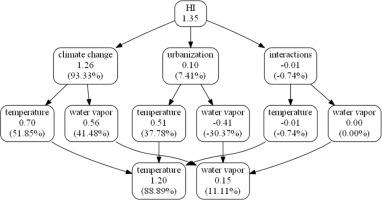Urban Climate ( IF 6.4 ) Pub Date : 2021-05-05 , DOI: 10.1016/j.uclim.2021.100866 Ziqian Wang , Zhixiang Xiao , Chi-Yung Tam , Weijuan Pan , Jilong Chen , Chenxi Hu , Chao Ren , Wei Wei , Song Yang

|
The individual and combined impacts of near-future urbanization and climate change on thermal environment in July over the Guangdong-Hong Kong-Macao Greater Bay Area (GBA) are projected. Results indicate that both the urbanization and climate change lead to near-future temperature rise, with comparable daily mean urban-warming of ~0.51 °C and ~ 0.70 °C respectively. In which, the two factors also enhance the probability of extreme heat events, especially the role from climate change. However, the relative contributions of two factors on human thermal comfort are very different. Urbanization leads to drier daytime but warmer nighttime, resulting in more comfortable daytime but uncomfortable nighttime. Under the changing climate, significant and uniform increase of Humidex (HI) can be found in whole day, suggesting future climate change intensifies human discomfort thoroughly. Climate change takes up ~93.33% of the total increased HI, attributing to both the caused temperature rise and humidity increase. Contrarily, urbanization only contributes ~7.41%, because the urban-reduced humidity offsets the effect of urbanized warming. It is further revealed that exposure duration of dangerous discomfort (HI ≥ 45) for the GBA residents will increase at least 8.87% in 2030 under the effects of climate change and urbanization, suggesting necessity of mitigating climate change in future megalopolis.



























 京公网安备 11010802027423号
京公网安备 11010802027423号